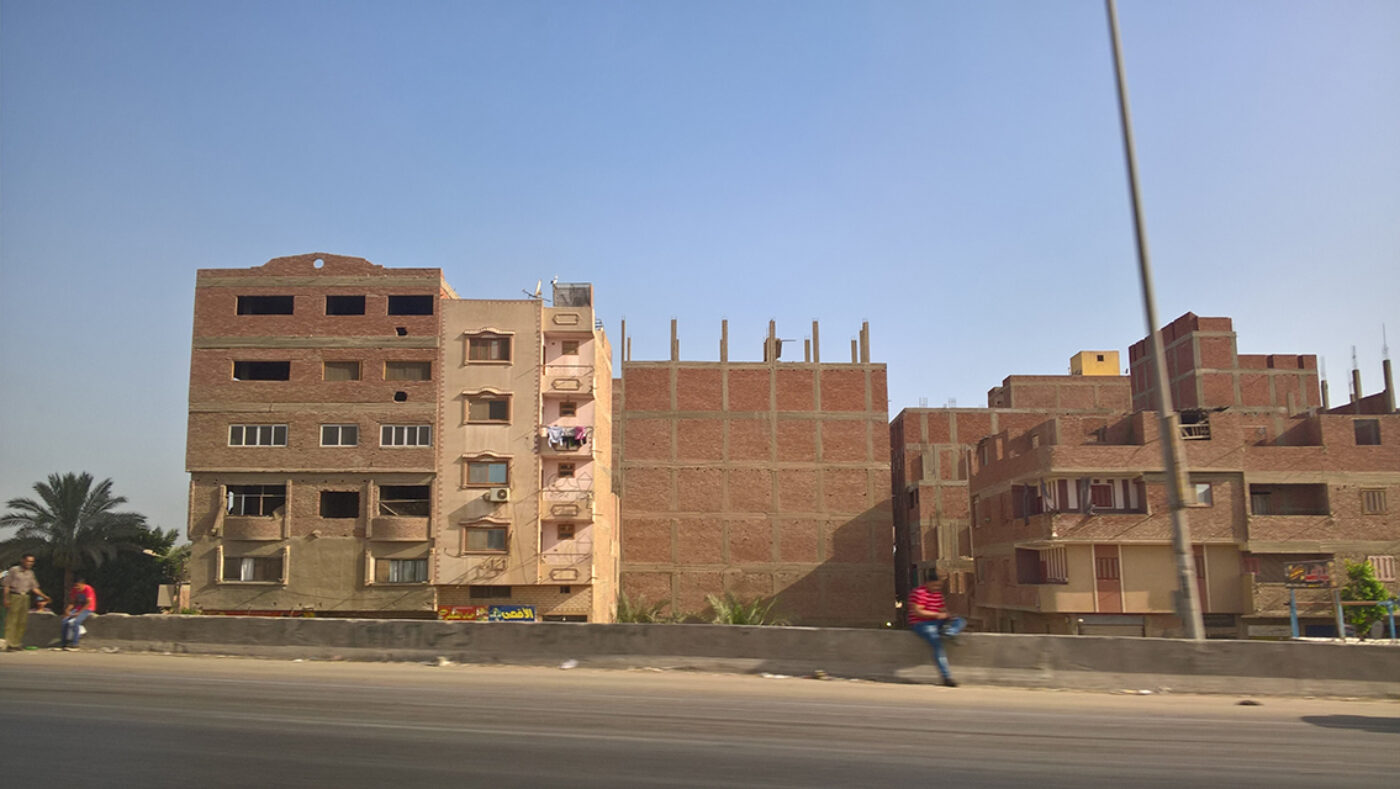
The red brick housing block of the informal settlements in and around Cairo are so recognizable and telling, that the national government is getting concerned about Egypt’s reputation. Not able to stop their spread, let alone to remove them, the government now ordered painting all exteriors to hide the reality of the day.1 Yasmin Mardini proposes a different interpretation of these neighborhoods, that ‘normal people’ will only see from the distance of their car. She shows the power of close reading as a way to understand and next, perhaps, to accept and integrate.
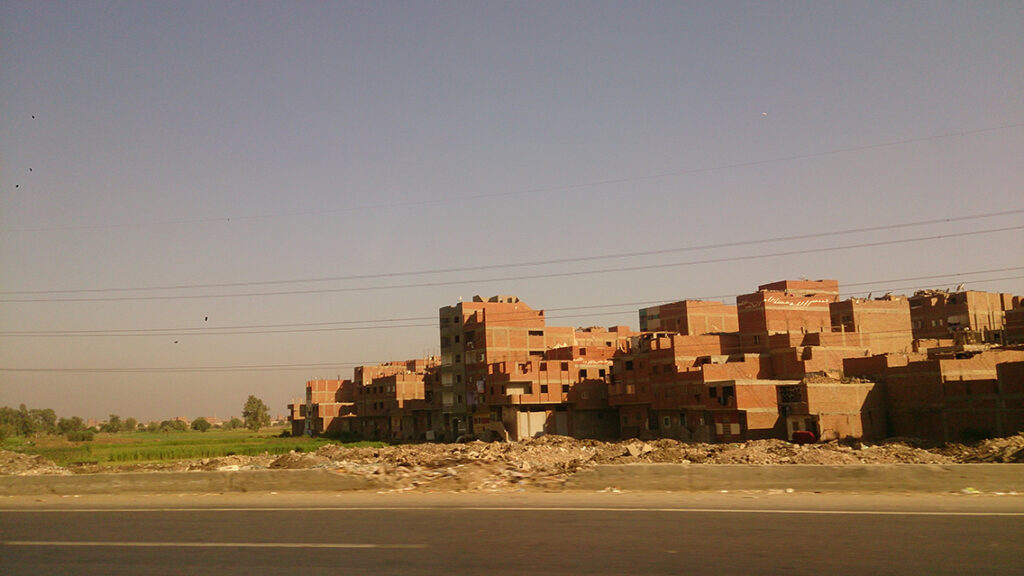
Told from the detached comfort of a passenger seat, the following accounts launch unsolicited – and very subjective – opinions on the informal settlements occupying both sides of El Salam Ring Road in Cairo, Egypt. Each narrative describes, analyzes, and proposes conclusions, both real and imagined, on (behalf of) the informal city that hope to circumvent the abused bias of the official local discourse on the subject. In itself, this piece is about questioning the metric upon which we judge and measure informal settlements and the tools that official (legal and architectural) entities brandish in the face of a phenomenon that they cannot immediately quantify, explain, categorize, compare, phrase, or swallow. By navigating through dystopian tropes, dismissive vocabulary, and dangerous romanticism of informality, this text ultimately aims to locate common ground – and describe it.
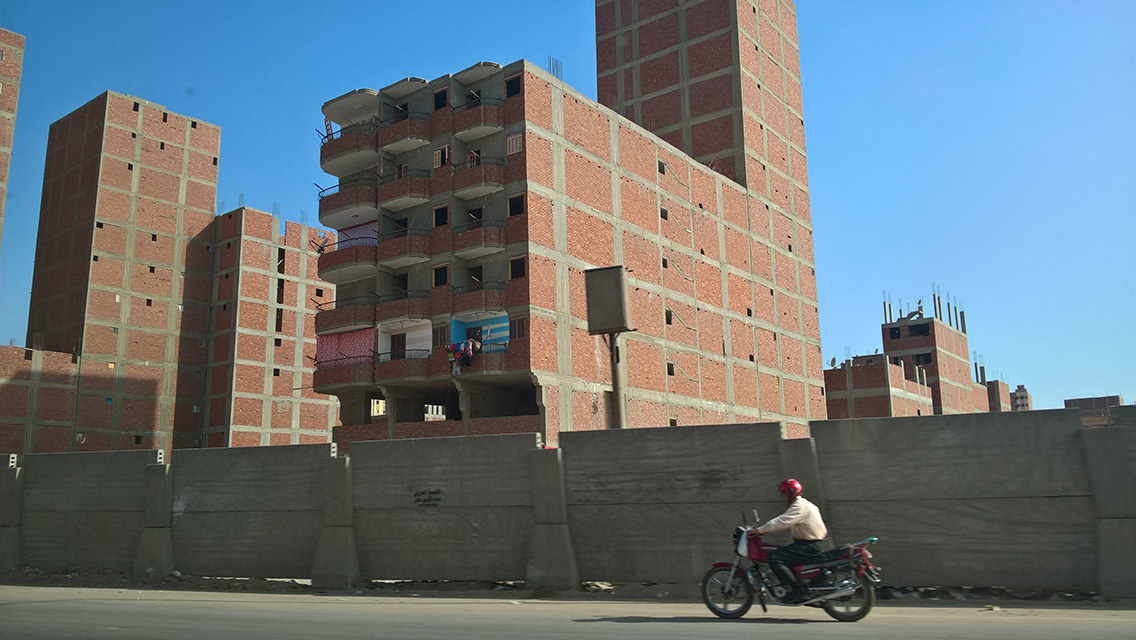
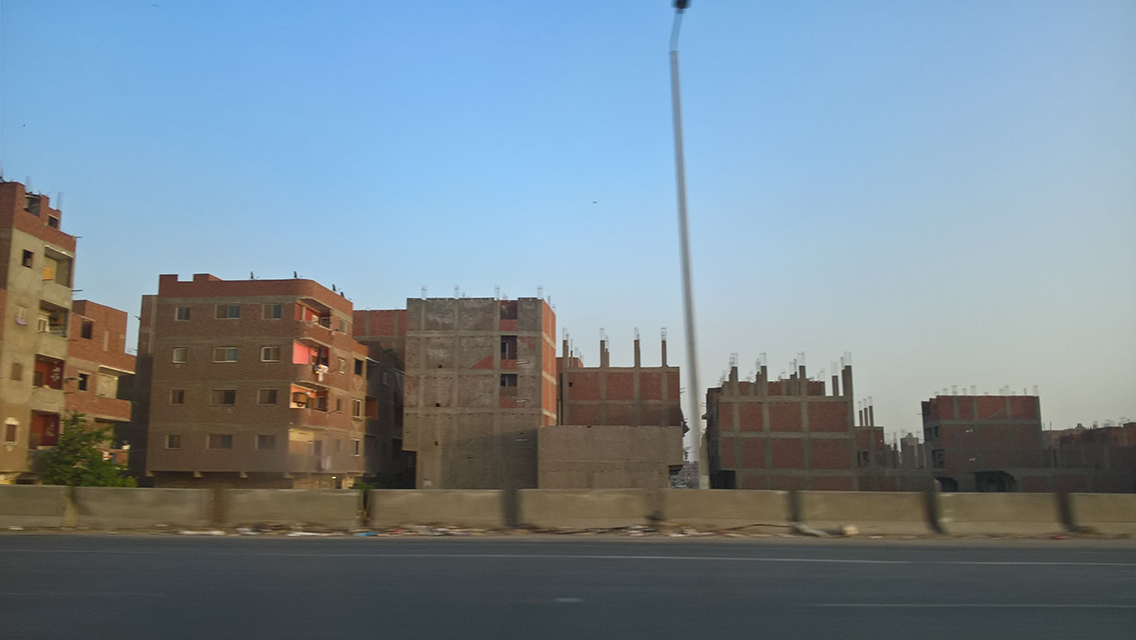
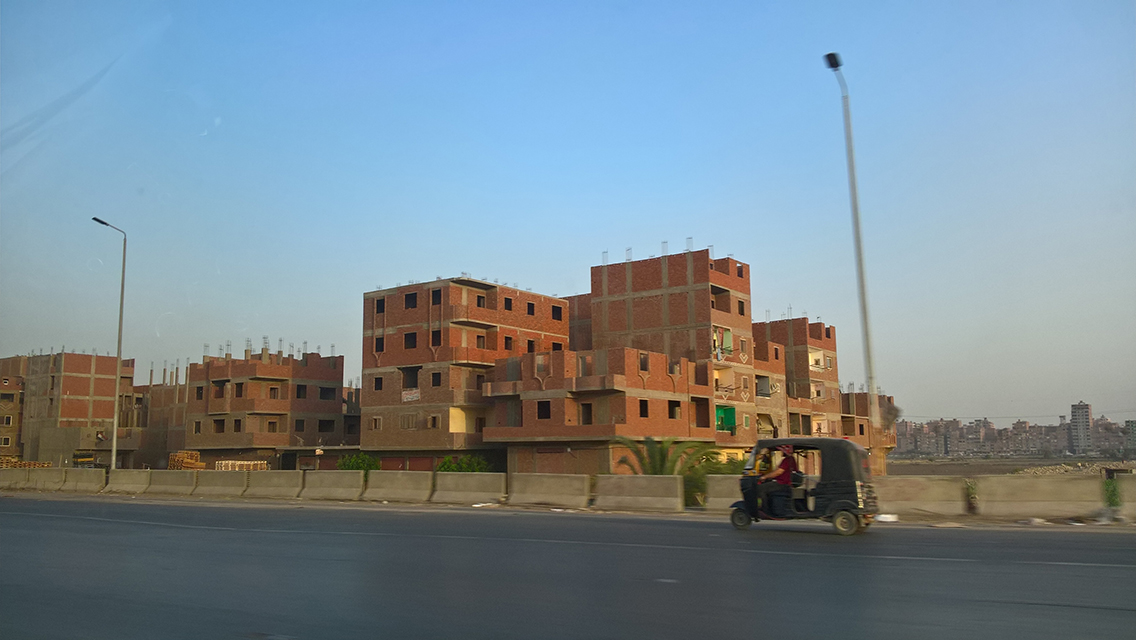
The Second Present
There is something oddly optimistic about investing to reserve space in a future you can neither picture nor describe. And according to official urban discourse, the informal settlements flanking both sides of El Salam Ring Road, among many others, have no discernable future.
And yet, viewed only through a windshield, the city appears to be thriving. Buildings of all forms, heights, orientations, plot sizes, and uncomfortably brash proximities occupy any and all land. There is no visible logic deterring the growth of this city; there is investment and, in answer, mass construction. Dynamic to the last, the city displays a remarkable reversal of order where buildings are under threat of demolition at their very inception, discolored and decayed before they are ever painted, and perpetually under construction while having apparently been long in use. Like shifting desert sands, the constructed forms you orient yourself to today might not resemble themselves tomorrow. And capacity is of no concern – the city does not know when or how to stop because it has never had to. Given the choice between reason and disorder, the city circumvents both and chooses potential every time.
In fact, sometimes potential, a flight of stairs, and a handful of reinforced concrete columns is enough to propel a concept forward in time. On the rooftop of what seems like every third building, continuing reinforced concrete columns shoot out with peaks of steel rebar in anticipation of what can only be described as aspiration. The informal city practices an act of claim for a future it cannot vouch for in the form of an extra story; an nth floor that wishfully occupies space in a different time. A single unenclosed, bare stairway usually stands at the center of this additional floor and leads to an, as of yet, immaterial landing. Each unmarked floor waits on top of a constructed building, unenclosed – free of the confines of red brick; threatening to further carve out the sky in a fit of aggressive optimism.
In truth, the future is indefinite for any city. To outlast its limitations, the informal city operates on a different sense of time. It invents its own threshold for capacity and maximums as it goes because it has no use for a formal metric that was built to assess an opposing reality altogether. Really, the extra floor phenomenon exists in defiance of an abused metric of absolute universal maximums and minimums. In the absence of a definite future, the extra placeholder floor straddles two timelines at once; the present and a patented second present. Having been repeatedly denied a formal future, the city chooses instead to invest in an extended present where it can thrive, unregulated and unhindered by formal processes – an extra day of the week to accommodate its extra logic.

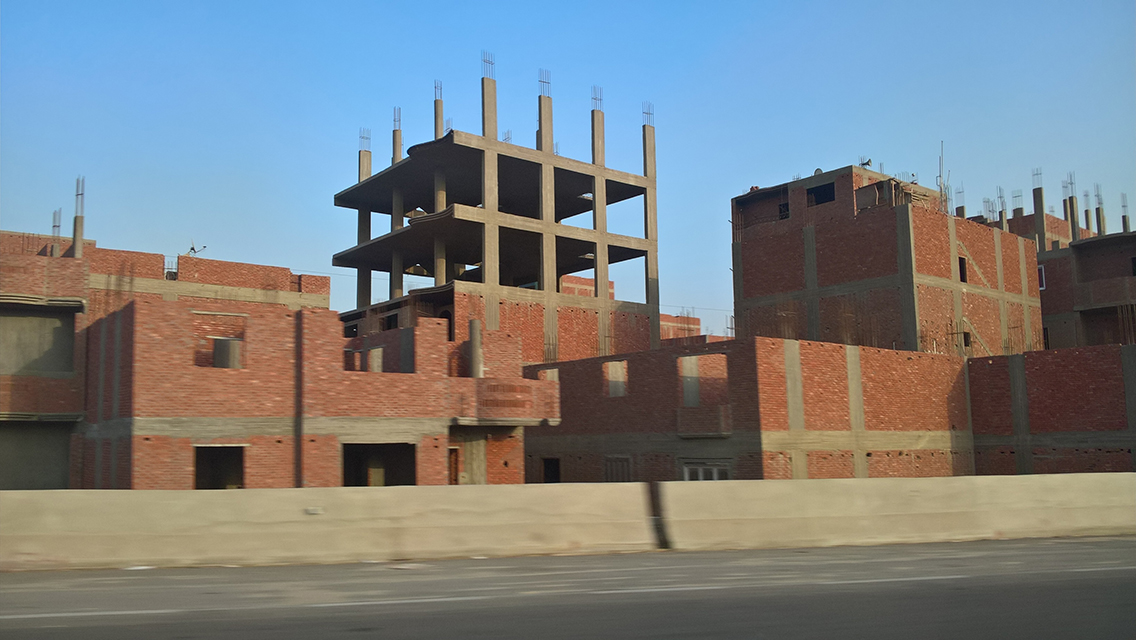
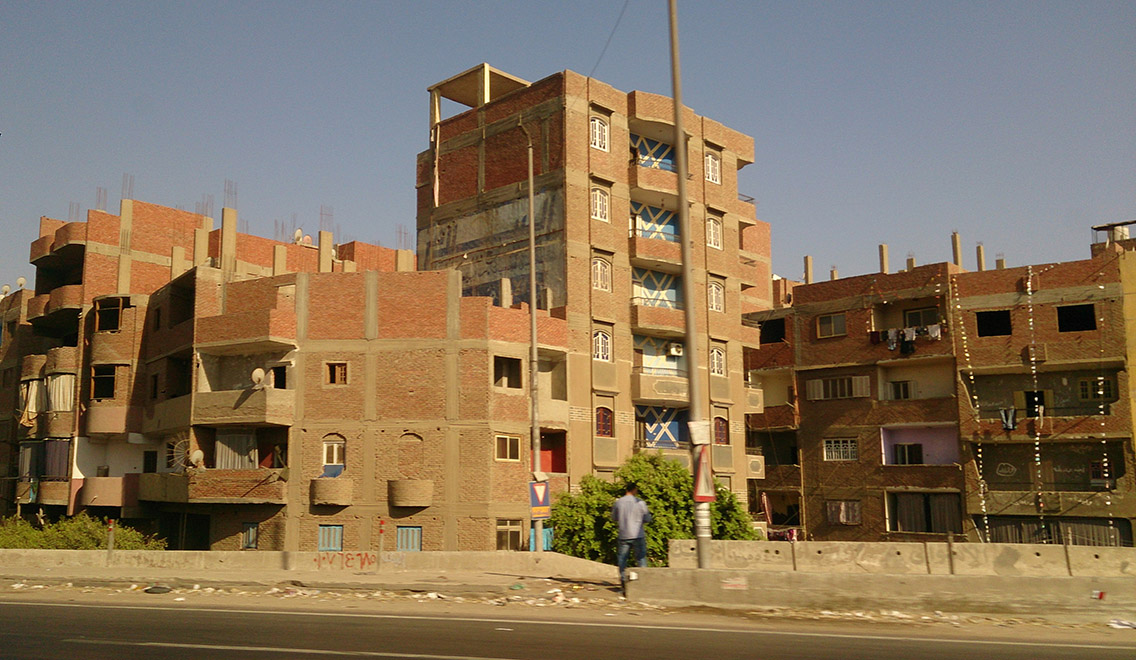
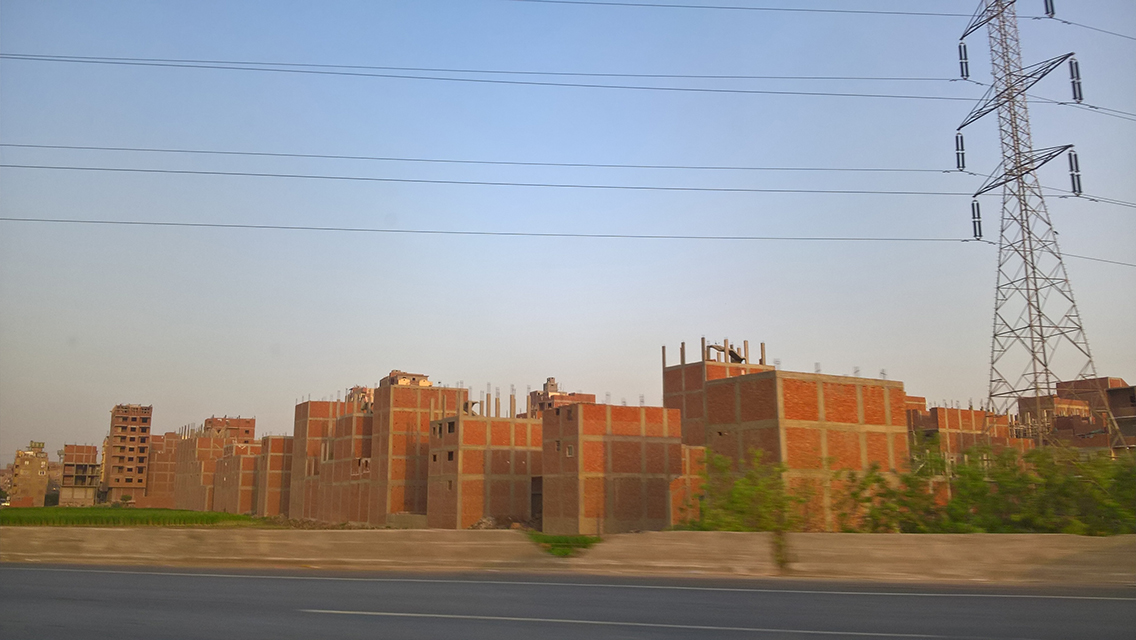
Pink Balcony
It is frustrating to note that for all its individual triumphs, the informal city is often feebly grouped and dismissed as a single entity. While the city is the retrospective outcome of a multitude of forms, preferences, and financial abilities, spread out on varied sizes of parcels, it remains almost entirely expressed in a single medium of red brick. Like a blanketing force, the ageless and placeless anonymity of the material abstracts the city to a point of uniformly spread culpability. And so, for all (formal) intents and purposes, red brick is conveniently synonymous with Criminal Poverty.
Long accustomed to prejudice, the informal city refreshingly has no qualms about its own representation. Its portrayal, uniform or otherwise, is released from obligations of communal responsibility. That is, exterior finishing is optional in informal cities. In this context, the previously innocuous act of painting is now suddenly laden with meaning and deliberation. You may not have to paint your informal apartment; but if or when you choose to do so, you must rise to the occasion. For nearly every twenty unfinished constructions, two painted buildings emerge against a modest foil of red brick. Selectively used in balconies, per tenant apartment, or throughout a façade, paint becomes a signifier of financial ability; a status symbol; a display of ownership. For buildings overlooking the ring road, uniformly painted façades mimic formal architecture in a calculated claim for (surface) legality even if it means only one out of four façades is actually ever painted. Advertisements, graffiti, spray painted telephone numbers of nearby businesses, patterns in brick spelling out names; paint is currency in an un-iconic city where land marking is relative to an absence of landmarks.
Night falls and the blanketing effect of darkness supersedes that of material. Unsurprisingly, electricity does not yet appear to be a guaranteed service for the entire length of the informal city along El Salam road. Ranging from unlit homes with visible rows of laundry to entirely-lit fifteen story buildings without fitted windows; the presence or absence of lighting is no longer a measure of occupancy. Flickering street lights paint a scene of abandoned neighborhoods, ones otherwise thriving in daylight. Closely followed by nearby areas along the same stretch of road where lighting on shop fronts is seemingly so readily available it is often left forgotten overnight. It only stands to reason that lighting, or a lack thereof, provides a reliable tracing of the intangible barriers between formal and informal territories; buildings sometimes tapping into a grid they geographically fall within, but legally fall short of.
From the outset, the informal city nullifies conjectures on occupancy and completeness typically associated with the presence of paint and lighting. Driving by this city, one would be hard- pressed to reconcile this acquired system of inference with a parallel reality where paint is only finishing and lighting is indicative of presence. In a reversal of order and priority, paint and lighting now assume the substantial role of representing the individual within the collective. In this reality, they are standalone architectural elements with connotations as dimensional and as disabling or enabling as fences or archways. Their evolved capacity as tools is here to advise us that the uniformly red informal city has no single author. In fact, the informal building floor has no single author; instead, amid a relentless conditioning of life, a single pink balcony emerges to represent only itself.

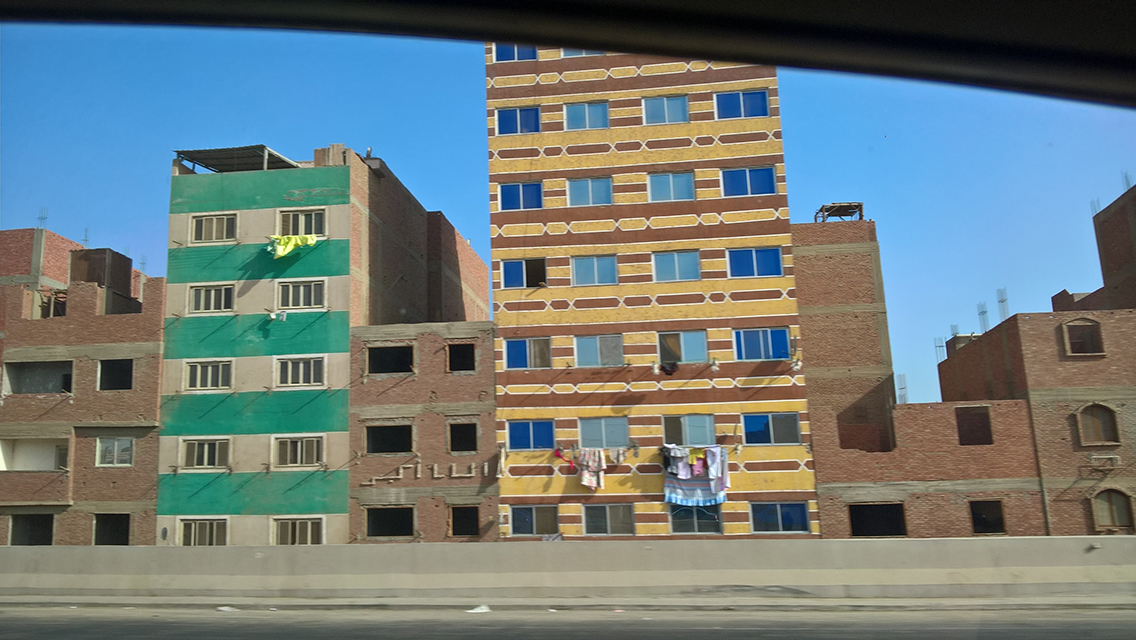
A City Post-Metric
Whether cause for alarm or fascination, the way each two buildings meet in this city certainly warrants description. Right away, upon the first encounter, the tension between buildings registers itself to be as focal to the observer as the buildings themselves. Hulking masses, windowless on three out of four façades, bolt themselves to nearby buildings in a manner more commonly standard of furniture joinery. Actually, if it were not for a prevalent three-meter column grid, the scene would appear to be out of scale. Buildings angled towards or away from the main street, collide to create corners of blank sidewalls that can only be penned as sculptural. Two story homes are glued to eight story apartment buildings; the sunset leaks through one-meter gaps between ten story constructions – the seams of the informal city are aggressively visible.
There are no lasting or reliable impressions for a city so averse to definition. Architecture here is manifold; it is at once tall and squat, close and distant, center and backdrop. Its forms, heights, and angles all conspire to dismantle any acquired ideals of spatial hierarchy. For the vast majority of this ring road, informal housing, flanking both sides of the road, presents passengers with the architecture of exception only. Built in response to different momentary urgencies, every building seems to have manifested in spite of context; the only rule to this perpetual exception being that all space is valuable. And credit where credit is due, the informal city especially manages to lend value to unbuilt space. Gone are the limited notions of inside and outside; the rooms, balconies, alleyways, and streets are all variations of continued space where every square meter, enclosure notwithstanding, thrives and serves a minimum of two purposes: space here is articulated in every medium.
But what happens when these very modes of spatial articulation are at odds with the established order? Planning thwarted, building codes unapplied, safety standards unheard of, patterns nonexistent; more and more the city begins to resemble the confirmation of our worst known formal and legal fears. The informal city is now a seemingly threatening organism that expands and contracts to assume the spatial boundaries it requires at any given moment; it is a spillover of architecture and people – a large material presence in answer to all previous and current absence. In itself, it represents every ideal that was banned from materializing on its elected formal counterpart. By all official accounts, the informal city should not have outlasted its predicted failure, and yet it has. It now exists in the aftermath of the greatest non-event in recent Cairene history; the money has not run out, the unsound buildings have not collapsed – the world has not ended. Our fears, of a thriving illegal community, of what we currently deem to be the absolute ‘worst’, may be confirmed and yet the most alarming aspect should not be that they are but that a new standard for the worst now has to emerge, a reinvention of a new low that we are reluctant to set or encourage.



(In)formal
Viewed from the vantage of a road that floats just above ground level, the informal city, darker and deeper below, appears to have sunk under the weight of its newfound emphasis. A splitting fault line, figurative yet plausible, emerges between the ring road and the informal settlement, insinuating the occurrence of a phenomenon well beyond our control – the informal city is now too heavy to budge. So much of the vocabulary used to describe informal urbanism perpetuates sullen imagery of tin shack slums and hovels. Meanwhile a healthy stock of reinforced concrete buildings of all kinds of unapologetic compositions continues to crop up in the vast majority of Cairo’s informal settlements. Compared to the exhaustively familiar past architectural frailty of a ‘slum’ of unsure shacks and shaky cardboard, today’s brand of informality is heavy – it is structurally sound, visibly able to support extensions, and dangerously similar, if not identical, to formal state architecture. Previously stymied by a material temporariness that invented and magnified the discrepancy between the official resident and the trespasser, the informal city has since learnt its lesson. The informal technique, now new and improved, knows not to invest in an easily overturned architecture and instead fortifies its claim by expending twice as much gravity as its formal equivalent and its own former self combined. Once merely a nuisance, the informal city today is a full-fledged problem. Not only is it difficult to dispel as a concept, prevent as an execution, and hurdle as a process, it is now also costly to tear down: a weight that has earned the city the right to persist by default. For stretches of kilometers, the striking mass of this sweeping urbanism dispels any wishful thoughts of dismantling this settlement in the future. It is not only anchored by reinforced concrete and brick; it is bolstered by having cause to exist and multiply: a need for housing and investment that cannot be imitated. Beyond material weight, it is a live load of necessity, people, aspiration, and money. More alarming still is a corresponding lingering heaviness of all the constructions that are yet to occur. For every blank, unperforated side wall (and there are many) situated around unbuilt land parcels, a building will surely emerge. Even this, the burden of construction that is present by absence; the phantom saturation point when the dreaded Tetris will be complete, lends it a gravity we cannot dispute.
When it comes to the informal city, what do we, formal-legal-official practitioners and residents, stand so firmly against? What is truly informal about the informal city? The legal faults of the informal logic are many and yet the spatial application of that logic offers a needed alternative. It is a form of urbanism that advances one possible answer to a question of demand in a specific socio-economic reality, at a certain location, during a particular time; the criminality seems to lie solely in the fact that this urbanism contends with an established norm. At every turn, our fixation on legal claim is thwarted. Armed with rhetoric, we condemn and dismiss, and our accusations bounce off the walls of a healthy construction boom that rivals our formal own – settlement we say, as in colony not community; informal as in unofficial, illegal, immoral even. And is it really a matter of legal claim? The truth is it does not matter if it is; the city is beyond the wishful point where it can still be discredited by paper. Bigger, vaster, heavier, the city is now a formidable contender to its formal counterpart. Beyond legality and unmet construction standards, the city succeeds in housing a majority. Slum, shanty town, squatter area, shack-land, favela; the language, the discriminatory euphemisms quite simply no longer apply – the informal settlement in our collective memories has ceased to exist. Our brand of informal city has shed and transcended its nomenclature; it is just another mode of urbanism experiencing triumphs and failures, a city of buildings that house people.
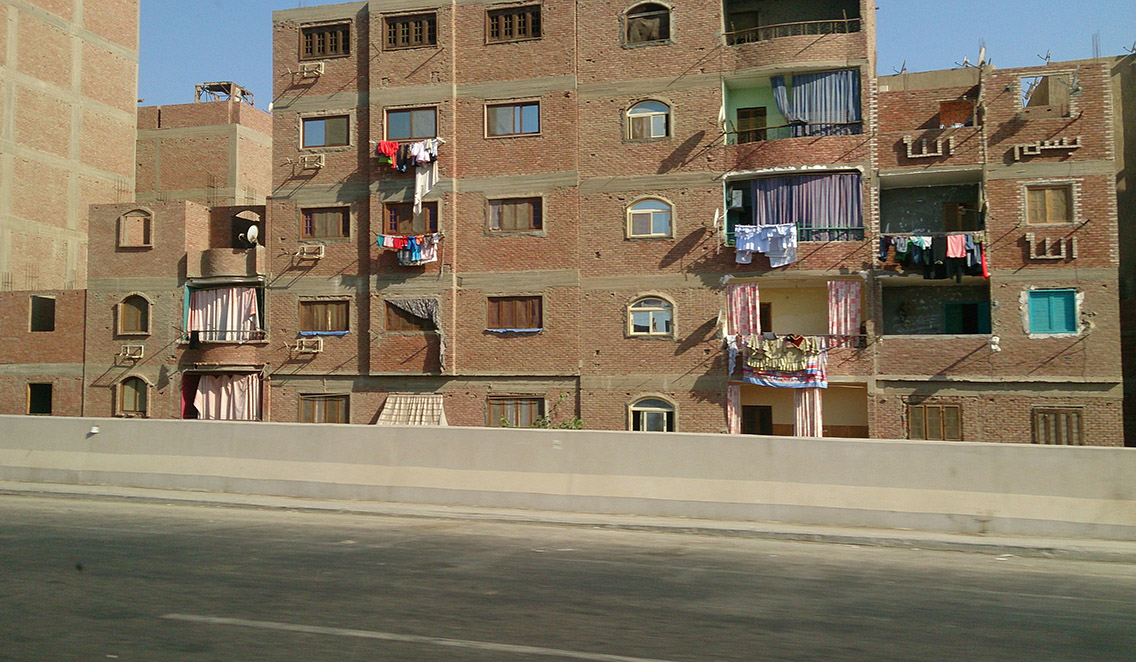
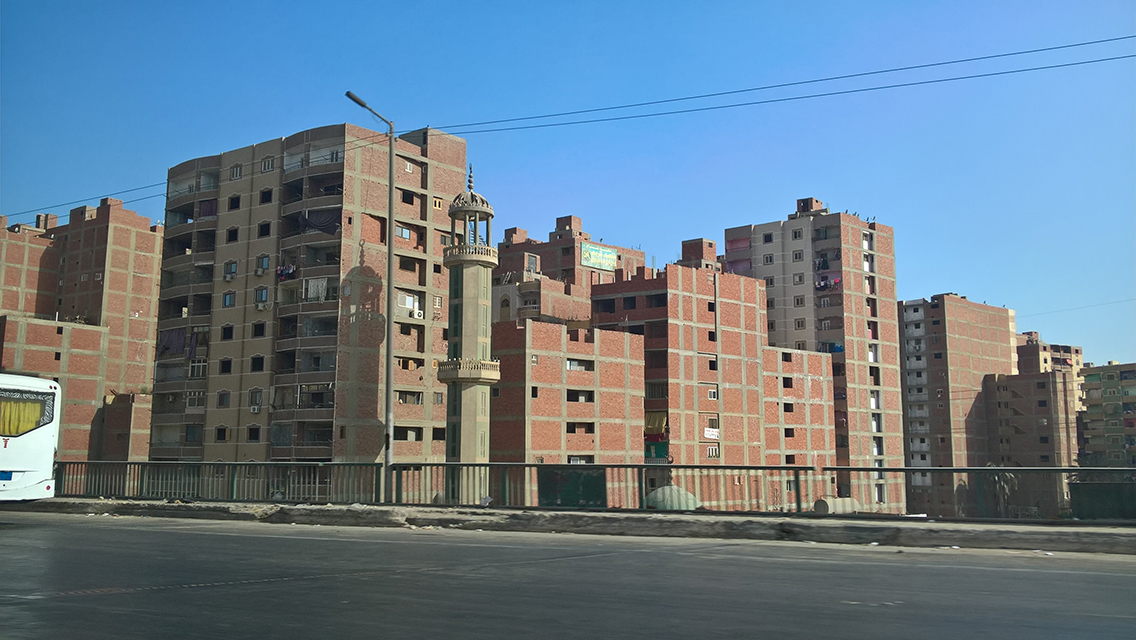
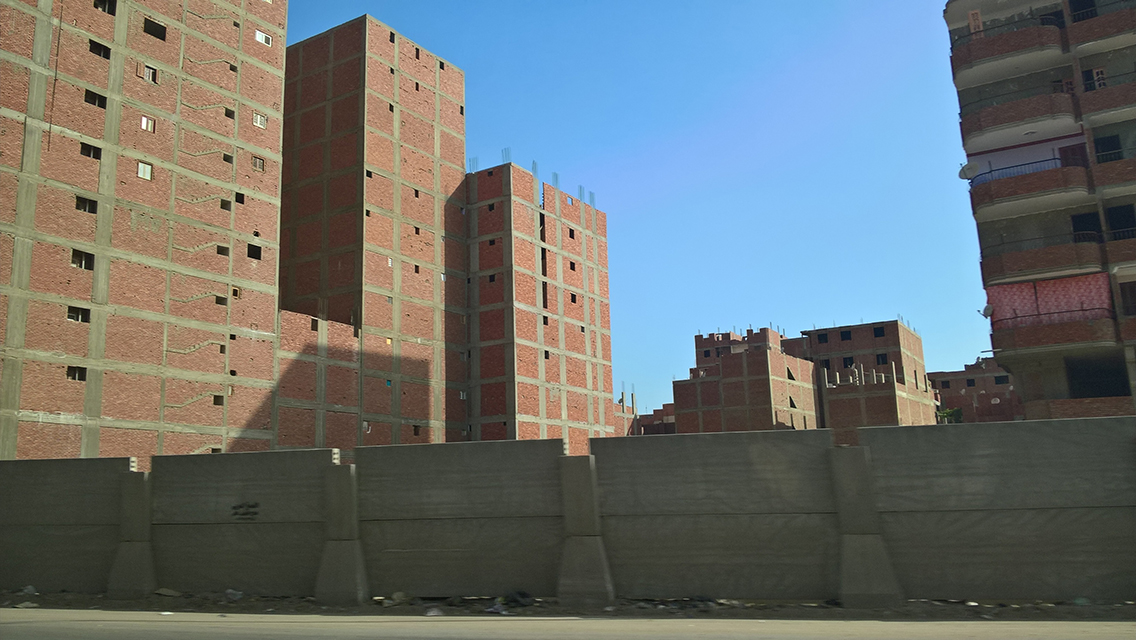
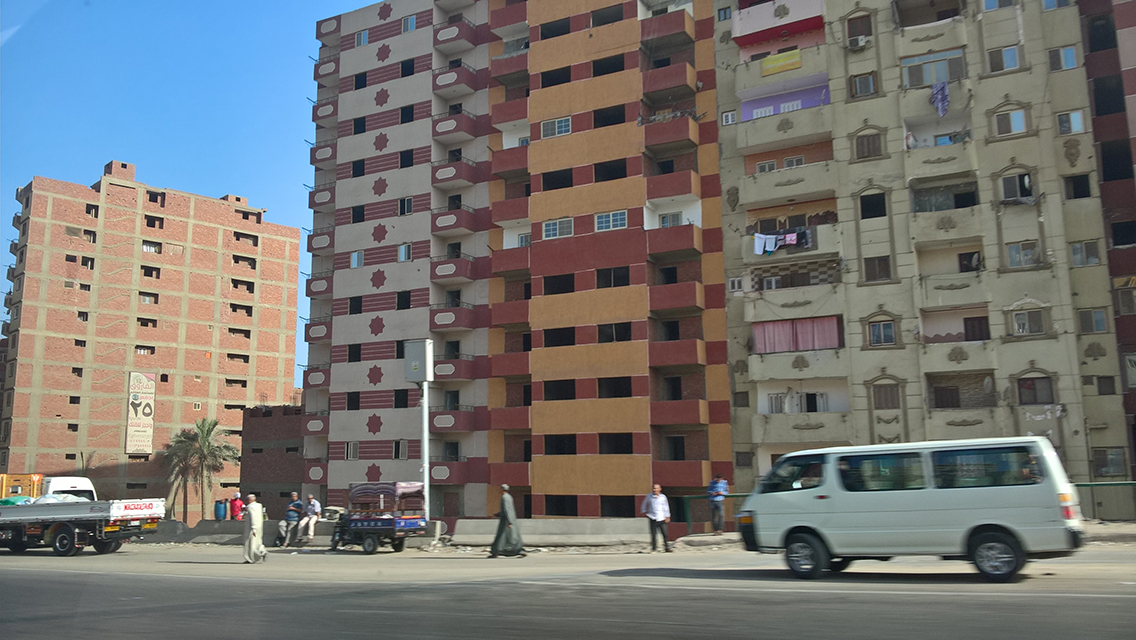
Mounting Indifference
In the grand scheme of any city, just how valid is one opinion told from the safe distance of a car? As a passenger observing and making your way around the city, the stakes are low. It is when you decide to stop in your tracks that the problems begin to appear.
There is much that stands between the passenger and the phenomenon. To begin with, the barriers we circumvent as academics, practitioners, and residents rival the literal fences that encircle most parts of this road. Much like the route confining the informal city, our circuitous legal and formal discourse currently serves no purpose beyond the inane preservation of inexplicably rigid ideals; the regressive propping up of a borrowed standard that is selectively preoccupied with flat ideals of good, bad, worse, and worst. Between a public education mostly predicated on the dismissal of informality and legislation intent on criminalizing it, very little room is left for discussion or even thought. A trained architect has no business acknowledging an informal settlement; if anything, our training prepares us for an altogether alternative reality where architecture cannot and will not occur without architects or sanction.
But the fact is as follows: we are as ill-equipped to understand the informal city as we are to intervene in its outcome. Like a fork to soup, our tools of top-down pattern and order fail us. There is a careless and very deliberate dissociation between discourse and reality that continues to breed apathy. In the face of a mounting indifference, the act of storytelling becomes a statement; an opinion to counter another in a setting where facts remain overlooked. While not entirely immersive, graduating from a position behind a desk to one behind a windshield brings us closer to scratching the surface of our own accumulating disinterest. To drive around, and conveniently, evade the informal city marks the triumph of our acquired indifference; the cyclic conditioning of life that puts a strain on any form of participation. To stop instead and offer an unsolicited narrative on a reality that eludes us grants us the right to verbalize the new normal; to perform the barest form of architecture: description.